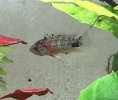Tristero
New Member
- Messages
- 6
Hi everone.
I'd like a bit of advice about a sick male Apistogrammoides.
I had been raising a pair in a very heavily planted 120L aquarium with various rasbora, tetra, kuhli loaches and catfish. They had been growing both in size and in confidence over 7 weeks, feeding mostly on grindal worms though the male had started to eat bottom feeder pellets. One day I noticed that the male seemed to be breathing a bit more labored, despite other behaviour being unchanged. The next day he hid all day (which was unusual), the following day I spotted him up the back obviously in trouble, and then he must have died in the day or 2 following that.
I took this photo showing that he had a vivid crimson blush on his sides which didn't look normal for that species. Does anyone want to hazard a guess at what went wrong, or give advice about how you can support a fish that starts to go downhill?
I'd like a bit of advice about a sick male Apistogrammoides.
I had been raising a pair in a very heavily planted 120L aquarium with various rasbora, tetra, kuhli loaches and catfish. They had been growing both in size and in confidence over 7 weeks, feeding mostly on grindal worms though the male had started to eat bottom feeder pellets. One day I noticed that the male seemed to be breathing a bit more labored, despite other behaviour being unchanged. The next day he hid all day (which was unusual), the following day I spotted him up the back obviously in trouble, and then he must have died in the day or 2 following that.
I took this photo showing that he had a vivid crimson blush on his sides which didn't look normal for that species. Does anyone want to hazard a guess at what went wrong, or give advice about how you can support a fish that starts to go downhill?
